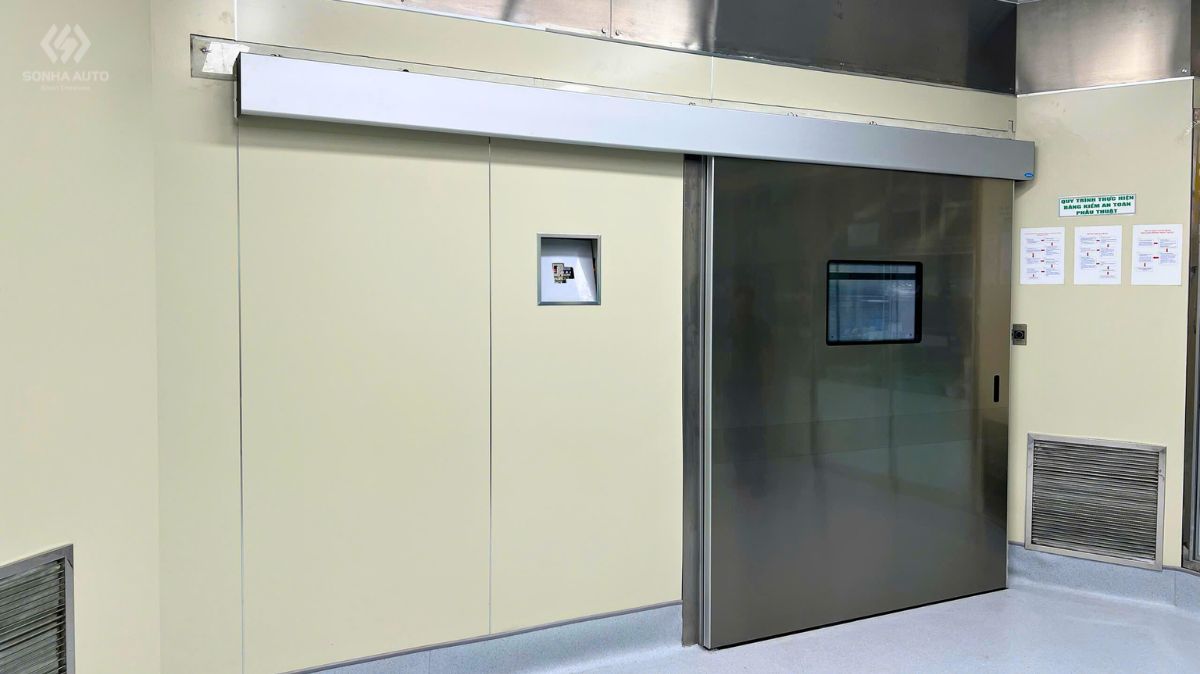In modern buildings, fire safety is always a top priority. Besides fire alarm and fire suppression systems, controlling smoke and temperature inside the structure is equally important. Automatic smoke exhaust windows were developed as an intelligent solution that allows smoke to escape more quickly, creating safe evacuation routes and reducing damage during a fire. So, what is an automatic smoke exhaust window and why has it become an essential part of high-rise buildings, shopping centers, and hospitals? This article provides an overview of its role, components, and standards to help you understand and choose the right system for your project.
What is an automatic smoke exhaust window?
An automatic smoke exhaust window is part of the fire protection system. It is a type of window integrated with an electric motor and intelligent controller, capable of automatically opening fully when receiving a fire alarm signal. Its main function is to create large ventilation openings at high positions, allowing toxic smoke, heat, and hot gases to escape quickly from the fire zone. These systems are typically installed in buildings, commercial centers, and factories, operating based on signals received from the fire alarm system.
Unlike regular windows, automatic smoke exhaust windows are designed according to fire safety standards. They offer excellent heat resistance, stable operation, and ensure no jamming occurs during fire spread.
Whether you are an investor, homeowner, MEP engineer, or aluminum-glass contractor, understanding what is an automatic smoke exhaust window helps you make the right decisions when designing and constructing your project.
In most fire incidents, toxic smoke—rather than flames—is the leading cause of fatalities. Automatic smoke exhaust windows are an important part of the Smoke and Heat Exhaust Ventilation Systems (SHEVS). They are considered the second line of protection after fire suppression systems. When activated, the windows open to release smoke and hot gases, maintaining visibility for escape, reducing the risk of smoke inhalation, and helping rescue teams reach the fire zone more quickly. This is a critical factor in ensuring life safety in any building.

Role of automatic smoke exhaust windows
- Rapid smoke extraction during a fire: Smoke and toxic gases spread faster than flames. When automatic smoke exhaust windows activate promptly, they create a path for smoke to escape, maintaining visibility and helping occupants find evacuation routes.
- Reducing temperature and toxic gases: Venting heat protects the building structure from collapsing due to extreme temperatures and reduces carbon monoxide concentration, increasing survival chances and enabling safer rescue operations.
- Supporting rescue teams: Improved visibility and lower temperatures help rescue forces conduct evacuation and firefighting more efficiently. This is one of the core safety roles of PCCC smoke exhaust windows.
- Integration with the fire alarm and smoke extraction system: The windows must operate synchronously with other building systems. Once smoke detectors trigger, not only do sprinklers activate, but smoke exhaust windows also open immediately to ensure comprehensive smoke control.
Components of an automatic smoke exhaust window
To better understand what is an automatic smoke exhaust window from a technical perspective, the system includes the following components:
| Component | Function |
| Motor and automatic opening mechanism | Heat-resistant electric motor with linkage arms or chain actuators that fully open the window (typically 90°) in a short time. |
| Smoke and heat sensors | Sensors integrated or connected to the fire alarm control panel, responsible for triggering automatic activation. |
| Window frame | Made from durable materials such as aluminum, steel, or stainless steel with heat resistance and fire spread prevention. |
| Fire-resistant panels | Typically tempered glass or special fire-resistant panels to maintain window integrity. |
| Opening arm mechanism | Mechanical structure that transfers motor force and supports the window’s weight. |

Operating principle
The operating principle is simple but highly effective:
- Automatic activation: When smoke or heat exceeds the threshold (around 70–90°C) or when the fire alarm sends a signal, the controller powers the motor.
- Emergency opening: The motor drives the arm or chain to fully open the window (90°) usually in less than 60 seconds.
- Manual operation: Many systems include an emergency push button (yellow or red) that allows manual activation.
- System integration: Windows must operate synchronously with the building’s smoke exhaust system according to preset programming.
- Reset: Once the fire signal is cleared, the windows close again to return the system to safe operation.
Types of automatic smoke exhaust windows
When learning what is an automatic smoke exhaust window, many people wonder which type is suitable for their building.
Based on the opening mechanism, automatic smoke exhaust windows are classified into:
- Automatic top-hung windows: Most common for vertical walls; allow smoke to escape while preventing rain entry.
- Automatic pivot/side-hinged windows: Often used for skylights or façades to create large opening areas.
- Automatic sliding smoke exhaust windows: Less common, used for large openings or balconies.
- Combined ventilation & smoke exhaust windows: Equipped with small motors for daily ventilation and larger motors for emergency smoke extraction.
Based on installation location: skylights, upper floors, corridors, technical rooms, etc.

Standards and regulations
Automatic smoke exhaust windows must comply with strict standards:
- Vietnamese fire safety standards (TCVN, QCVN): Define minimum smoke exhaust area for each building type.
- European EN 12101-2: Widely accepted, specifying wind load, mechanical durability, opening speed, reliability, and heat resistance.
- Minimum opening requirement: Must achieve required free opening area.
- Maintenance recommendations: Periodic inspection of motors, sensors, and fire safety connections.
Applications
- Shopping malls, high-rise buildings: corridors, lobbies, basements, and rooftops.
- Factories, cold storage, machine rooms: fire-prone or high-heat areas.
- Hospitals, schools, hotels, airports: ensuring evacuation for vulnerable users.
- Combined systems: windows for daily ventilation + emergency smoke exhaust function.

Advantages and disadvantages
Advantages
- Fully automatic activation.
- Enhances safety by reducing smoke and heat.
- Minimizes structural damage.
- Easily integrates with BMS for monitoring.
Disadvantages
- Higher cost due to specialized motors and fire-rated components.
- Requires regular maintenance of motors, sensors, and PCCC connectivity.
Buying guide
When choosing automatic smoke exhaust windows, consider:
- Choose reputable brands: Such as TOPP (Italy) or Heinda (China).
- Check PCCC standards and certifications: Ensure EN 12101-2 and Vietnamese fire safety verification.
- Select suitable motor capacity: Must withstand wind load and sash weight.
- Ensure system compatibility: Must synchronize with existing fire alarm and smoke exhaust systems.
>>> See more: What is an automatic window? Operating principle, structure, and popular types in 2025
Conclusion
We hope this article has helped you understand what is an automatic smoke exhaust window—its structure, operating principle, classification, purchasing standards, and applications. This is not just a “nice-to-have” device but an essential fire safety solution.
If you are a building owner, contractor, or homeowner, installing automatic smoke exhaust windows—also known as fire safety smoke windows or electrically controlled smoke exhaust windows—is the best way to ensure safety and meet PCCC requirements.
Contact Sonha Auto for expert advice and the most suitable smoke exhaust window solutions for your project.



